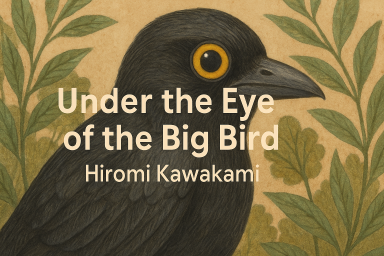Under the Eye of the Big Bird Review - Hiromi Kawakami
BOOKS REVIEW
Chaifry
7/9/20257 min read


Hiromi Kawakami’s Under the Eye of the Big Bird, translated from Japanese by Asa Yoneda and published by Soft Skull Press (2024) and Granta Books (2025), is a visionary novel-in-stories shortlisted for the 2025 International Booker Prize. Renowned for Strange Weather in Tokyo, Kawakami crafts a speculative tapestry spanning eons, imagining a future where humanity, battered by cataclysms, survives in fragmented tribes under AI-like “Mothers” and enigmatic “watchers.” Inspired by the 2011 Fukushima Daiichi nuclear meltdown, the novel probes humanity’s fraught relationship with technology, nature, and survival, earning acclaim for its “crystalline clarity” (International Booker Prize Judges, 2025).
For Indian readers, this work resonates with the philosophical depth of the Upanishads, the cyclical time motifs of the Mahabharata, and the emotional intensity of Punjabi poetry by Amrita Pritam or Shiv Kumar Batalvi. Its themes of love, loss, and environmental stewardship echo India’s urgent discourse on climate change and community resilience. This review argues that Under the Eye of the Big Bird is essential reading for its luminous prose, innovative structure, and profound reflections on humanity’s future, urging Indian readers to reimagine connection and survival in a precarious world.
Under the Eye of the Big Bird unfolds through fourteen interconnected vignettes set in a distant future where humanity teeters on extinction, surviving in isolated communities shaped by genetic engineering and AI oversight. The opening story, “Keepsakes,” introduces a narrator, one of many “Mothers,” raising children crafted from animal DNA: “None of us is allowed to know what our animal of origin is” (Kawakami, 2024, p. 3). These children, infused with rabbit or dolphin cells, live brief lives, and survivors collect “analogous bones” resembling miniature skulls of their animal ancestors. The Mothers orchestrate reproduction to preserve humanity’s genetic diversity, yet the narrator laments, “If we lose the children, that’s the end of the world” (Kawakami, 2024, p. 12).
The stories explore diverse human adaptations: some photosynthesize like plants, absorbing “nutrients from water and light, like a plant” (Kawakami, 2024, p. 47), while others are clones grappling with identity: “I asked me, but I shook my head” (Kawakami, 2024, p. 89). The non-linear narrative leaps across millennia, with characters reappearing as myths or under new guises, weaving a fragmented yet cohesive saga of evolution. A late chapter reflects on humanity’s enduring contradictions: “Did the humans keep loving and hating one another, even up to the end? … They were constant; almost admirably so, all the way until the end” (Kawakami, 2024, p. 231). The titular “big bird,” an enigmatic symbol of oversight or fate, looms subtly: “Don’t let the big bird get you” (Kawakami, 2024, p. 198). The final story offers a poignant plea from a narrator uncertain of being heard: “I wanted to reach back into the page and say, you are” (Kawakami, 2024, p. 245). Through these vignettes, Kawakami meditates on love, destruction, and the fragile hope for humanity’s renewal.
Under the Eye of the Big Bird is a speculative triumph, blending crystalline prose with profound philosophical inquiry, making it a vital read for Indian readers. Kawakami’s writing, translated with nuance by Yoneda, balances detachment and warmth, as seen in the clone’s introspective confusion: “I asked me, but I shook my head” (Kawakami, 2024, p. 89). This clarity resonates with the lyrical intensity of Punjabi poets like Amrita Pritam, whose Ajj Aakhaan Waris Shah Nu evokes raw emotion, captivating readers in Punjab’s literary circles or Mumbai’s bookstores.
The novel’s structure—fourteen vignettes spanning eons—creates a mosaic that mirrors India’s cyclical concepts of time, such as samsara. The interconnected stories, from photosynthetic humans to AI-driven Mothers, tie speculative innovation to universal human experiences, like the narrator’s fear: “If we lose the children, that’s the end of the world” (Kawakami, 2024, p. 12). This echoes the communal ethos in Indian narratives, like Premchand’s Godan, resonating with readers who value family continuity. The feminist reimagining of motherhood, as seen in the narrator’s caregiving—“Sometimes I try to remember all the children I’ve raised so far… the number must easily be over fifty” (Kawakami, 2024, p. 17)—speaks to Indian women navigating societal roles, akin to the resilient matriarchs in Shiv Kumar Batalvi’s poetry.
Kawakami’s environmental concerns, rooted in Fukushima, align with India’s climate challenges. The depiction of humans adapting to a faltering planet—“nutrients from water and light, like a plant” (Kawakami, 2024, p. 47)—encourages reflection on sustainability, from water scarcity in Chennai to deforestation in the Northeast. This connects with India’s Swachh Bharat campaign, inspiring mindful living. The novel’s brevity—256 pages—and emotional depth make it accessible, while its meditation on love and hate—“They were constant; almost admirably so, all the way until the end” (Kawakami, 2024, p. 231)—mirrors the emotional dualities in Punjabi literature, such as Surjit Patar’s poems of longing and loss.
The novel’s fragmented narrative can feel disorienting, as some vignettes, like the abrupt shift to clones, lack cohesion. Indian readers accustomed to the sweeping narratives of Rushdie or the emotional depth of Amrita Pritam’s Raseedi Ticket may find this structure challenging, especially younger readers seeking linear storytelling. The robotic tone, particularly in descriptions like “None of us is allowed to know what our animal of origin is” (Kawakami, 2024, p. 3), may feel cold compared to the warmth of Indian novels like Anita Nair’s Ladies Coupé, potentially alienating readers in rural Punjab or Kerala.
The ambiguity of the “big bird”—“Don’t let the big bird get you” (Kawakami, 2024, p. 198)—may frustrate readers who prefer the clear resolutions of Indian classics like Tagore’s Gora. The Western and Japanese setting limits direct engagement with India’s issues like caste or communal harmony, unlike Heart Lamp, the 2025 Booker winner, which addresses local struggles. The reliance on sci-fi tropes like cloning may feel distant to readers in smaller Indian towns, where traditional storytelling dominates. Finally, the novel’s speculative abstraction may not fully capture the visceral emotion Indian readers expect from works like Batalvi’s Loona, reducing its immediate resonance.
Read these also
Why Indian Readers Must Read This Book
Under the Eye of the Big Bird is a must-read for Indian readers because its speculative vision, philosophical depth, and emotional resonance align with India’s rich literary and cultural heritage, offering a transformative lens to explore resilience, connection, and humanity’s future. For readers in urban hubs like Chandigarh or rural Punjab villages, the novel’s portrayal of fragmented tribes mirrors India’s diverse yet interconnected communities, where bonds persist despite challenges like migration or social divides. The narrator’s role in raising genetically engineered children—“Sometimes I try to remember all the children I’ve raised so far… the number must easily be over fifty” (Kawakami, 2024, p. 17)—echoes the nurturing roles of Indian women, from matriarchs in joint families to community caregivers in Punjab’s rural heartlands. This resonates with readers familiar with Amrita Pritam’s Pinjar, where women endure and nurture amidst societal upheaval, offering a poignant reflection on caregiving under pressure.
The novel’s meditation on time and evolution aligns with Indian philosophical concepts like samsara and kaal, inviting readers to reflect on life’s cyclical nature. The narrator’s plea—“I wanted to reach back into the page and say, you are” (Kawakami, 2024, p. 245)—captures a longing for legacy, akin to ancestral rituals during Pitru Paksha in Varanasi or Punjab’s memorial traditions. This connects with readers who cherish continuity, as seen in Shiv Kumar Batalvi’s poetry, where love and loss transcend time, like in Mainu Vida Karo. The exploration of human duality—“They were constant; almost admirably so, all the way until the end” (Kawakami, 2024, p. 231)—mirrors the emotional intensity of Punjabi literature, such as Surjit Patar’s Hawa Vich Likhe Harf, where love and conflict coexist, making it relatable to readers across India’s cultural mosaic.
Kawakami’s environmental concerns, inspired by Fukushima, resonate with India’s urgent climate challenges. The depiction of humans adapting to a dying planet—“nutrients from water and light, like a plant” (Kawakami, 2024, p. 47)—prompts reflection on sustainability, from water conservation in drought-prone Tamil Nadu to afforestation in Punjab’s Majha region. This aligns with initiatives like Swachh Bharat or Punjab’s Harbhagat Nirman tree-planting drives, inspiring readers to embrace mindful living. The novel’s speculative framework challenges readers to question technology’s role, a pressing concern in India’s tech hubs like Bengaluru, where AI shapes daily life, yet rural readers in Amritsar may relate to the novel’s call to reconnect with nature, as in Guru Nanak’s teachings of harmony with creation.
The novel’s feminist themes, particularly the Mothers’ caregiving burden, resonate with Indian women navigating societal expectations, from urban professionals in Delhi to rural homemakers in Punjab. The narrator’s role echoes the resilience in Pritam’s Kagaz Te Canvas, where women assert agency amidst constraints. The novel’s brevity—256 pages—makes it accessible for readers balancing studies or work, from students in Ludhiana to farmers in Haryana. Its haunting imagery, like collecting “analogous bones” (Kawakami, 2024, p. 3), evokes rituals of remembrance, akin to Punjab’s folk traditions of honoring the departed through song or storytelling. For readers seeking introspective fiction, the novel’s hopeful undertones—“Don’t let the big bird get you” (Kawakami, 2024, p. 198)—offer a transformative call to preserve love and hope, resonating with India’s ethos of community and optimism, as seen in festivals like Lohri or Diwali.
Under the Eye of the Big Bird by Hiromi Kawakami is a luminous, visionary novel-in-stories that earns its place on the 2025 International Booker Prize shortlist. Its crystalline prose, captured in quotes like “None of us is allowed to know what our animal of origin is” (Kawakami, 2024, p. 3) and “I wanted to reach back into the page and say, you are” (Kawakami, 2024, p. 245), weaves a profound meditation on humanity’s evolution and resilience. For Indian readers, the novel’s philosophical depth, environmental resonance, and emotional intensity, enriched by parallels to Punjabi writers like Amrita Pritam and Shiv Kumar Batalvi, make it an essential read, despite minor challenges with its fragmented narrative and abstract tone. Its vivid imagery, from photosynthetic humans to analogous bones, and its call to reimagine humanity’s future inspire reflection on India’s cultural and ecological challenges. Highly recommended, Under the Eye of the Big Bird is a timeless invitation for Indian readers to cherish connection, hope, and sustainability in a fragile world.
